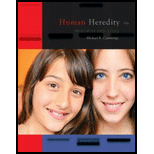
Concept explainers
To predict: The treatment strategies for phenylketonuria (PKU).
Introduction: Phenylketonuria is a recessive disorder that mainly affects the Caucasian and the Asians. The diseases are marked by increased levels of phenylalanine in the blood which can result in intellectual disability and other physiological problems.
The case study describes a couple who have given birth to a second child and are informed about their newborn daughter’s genetic screening tests. The genetic tests indicated abnormally high levels of amino acid phenylalanine in the blood. Phenylketonuria (PKU) also known as hyperphenylalaninemia.
This occurs 1 in every 10,000 births. The classic form of PKU constitutes to 2/3rd of the cases. It is an autosomal recessive disorder implying that both the alleles of the patient are affected. When untreated it can lead to intellectual disability, seizures, and hyperactivity. The EEG shows abnormality along with the prominent mousy odor of skin, hair, and urine.
Trending nowThis is a popular solution!

Chapter 3 Solutions
Human Heredity: Principles and Issues (MindTap Course List)
- 1. Match each vocabulary term to its best descriptor A. affinity B. efficacy C. inert D. mimic E. how drugs move through body F. how drugs bind Kd Bmax Agonist Antagonist Pharmacokinetics Pharmacodynamicsarrow_forward50 mg dose of a drug is given orally to a patient. The bioavailability of the drug is 0.2. What is the volume of distribution of the drug if the plasma concentration is 1 mg/L? Be sure to provide units.arrow_forwardDetermine Kd and Bmax from the following Scatchard plot. Make sure to include units.arrow_forward
- Choose a catecholamine neurotransmitter and describe/draw the components of the synapse important for its signaling including synthesis, packaging into vesicles, receptors, transporters/degradative enzymes. Describe 2 drugs that can act on this system.arrow_forwardThe following figure is from Caterina et al. The capsaicin receptor: a heat activated ion channel in the pain pathway. Nature, 1997. Black boxes indicate capsaicin, white circles indicate resinferatoxin. a) Which has a higher potency? b) Which is has a higher efficacy? c) What is the approximate Kd of capsaicin in uM? (you can round to the nearest power of 10)arrow_forwardWhat is the rate-limiting-step for serotonin synthesis?arrow_forward
 Human Heredity: Principles and Issues (MindTap Co...BiologyISBN:9781305251052Author:Michael CummingsPublisher:Cengage Learning
Human Heredity: Principles and Issues (MindTap Co...BiologyISBN:9781305251052Author:Michael CummingsPublisher:Cengage Learning Medical Terminology for Health Professions, Spira...Health & NutritionISBN:9781305634350Author:Ann Ehrlich, Carol L. Schroeder, Laura Ehrlich, Katrina A. SchroederPublisher:Cengage Learning
Medical Terminology for Health Professions, Spira...Health & NutritionISBN:9781305634350Author:Ann Ehrlich, Carol L. Schroeder, Laura Ehrlich, Katrina A. SchroederPublisher:Cengage Learning





